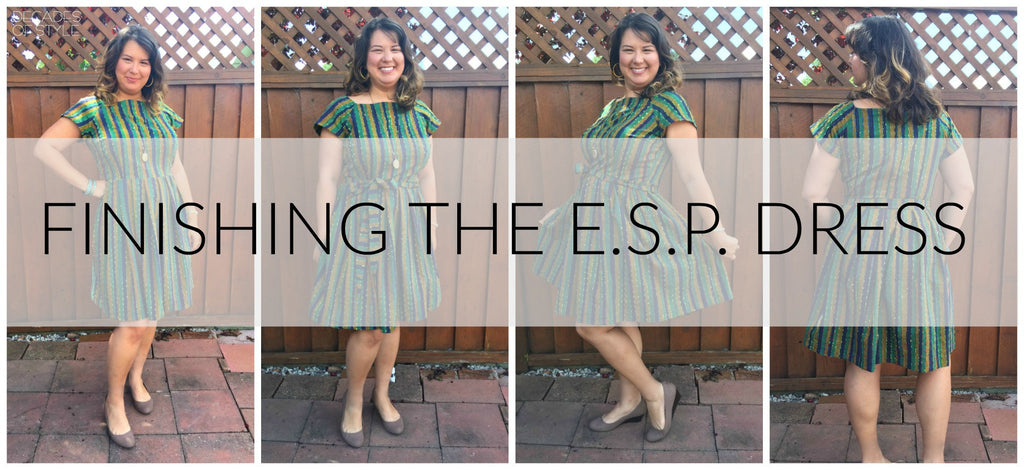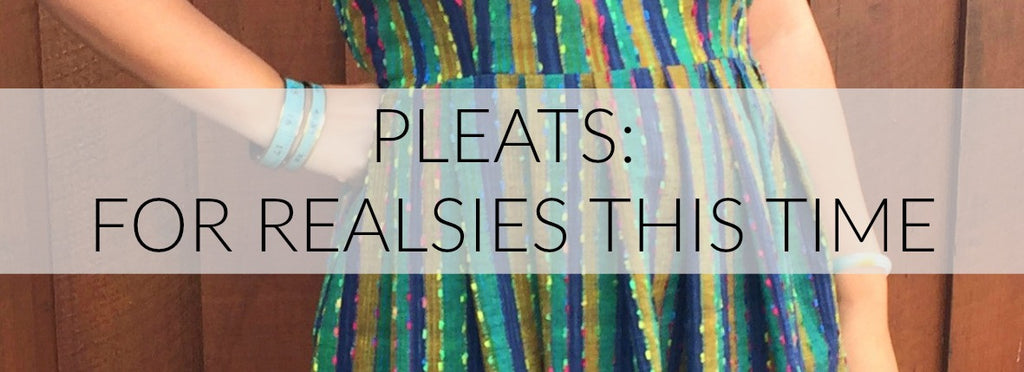News
E.S.P. Dress: Getting It Done July 26 2016 1 Comment
Just when you were thinking the E.S.P. dress was going to be an eternal UFO (unfinished object), here is the last installment of the sew along. We could go on and on about the fun things you can do with the E.S.P. dress, but we released a new pattern, the Cats Cradle dress, and we want to get to that sew along as soon as possible. Lets run though one more pattern adjustment that you can make and a few details of finishing the E.S.P.!
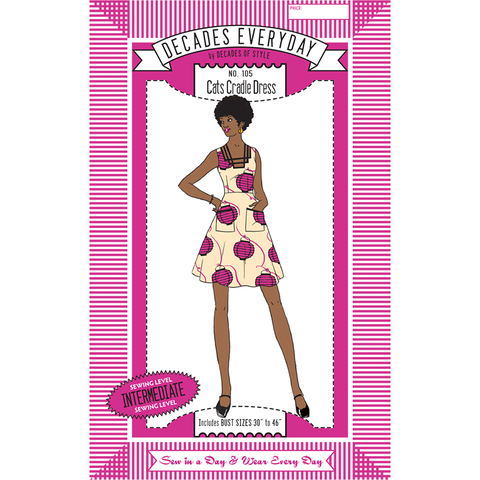
Sleeveless E.S.P.
A bit more work but a fun alternative for hot summer days. You will not be needing the bodice facing pieces for this adaptation.
Things you need:
1 yard of 1" wide bias. We prefer to make our own bias as purchased bias tape can be hard to manipulate. Feel free to use some fun contrasting fabric as no one will see it... unless you want them to.
2 yards of 3/8" - 1/2" ribbon or make your own tie.
Cut the bodice front and back with an additional 3/8" at the top of the neckline. Stay stitch the armscye a scant 5/8" from the edge.
Sew your bodice darts, attach the skirt to the bodice front and back. Measure 9" from the top of the bodice back down the center back and clip into the seam allowance, about 5/8" (to the seam line). Turn in the seam allowance 1/4" then again 3/8" and sew down. Or, if you have a serger, overlock the center back seam and turn and sew it down. The zipper will now start 9" below the neckline. Insert the zipper to the center back.

Trim the armscye seam allowance 3/8". Now, fold the free edge of the bias about 1/4" and press (the pressing really helps here). Attach the bias, right sides together using a 1/4" seam allowance, to the armscye, trimming any excess at the ends. Grade the seam allowance of the bias. Then turn bias along the seam line toward the inside of the bodice and stitch 1/8" near the fold. Need a super detailed tutorial on this technique? Victory Patterns has a lovely tutorial on bias finishing edges which can be applied to making a sleeveless dress.
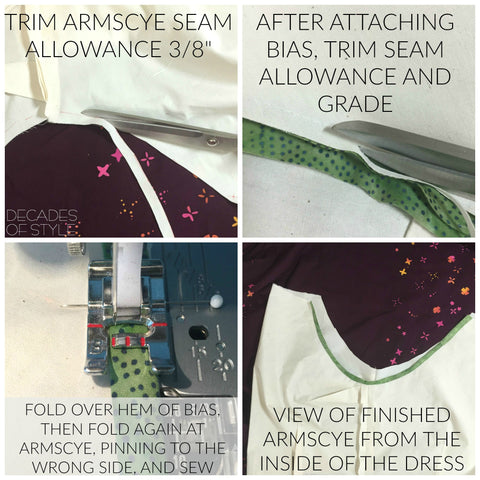
Fold and iron neck line of the bodice front and back 1/4", then again 1/2", pin and sew down, sewing a scant 1/8" from the hem line. You have just made your neckline casing.
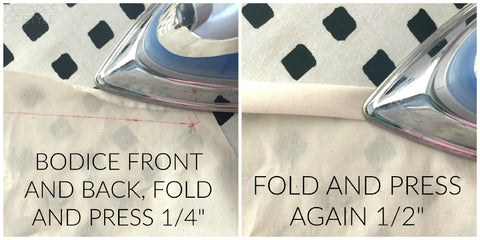
Now thread the neckline casings with your ribbon having it start and finish at the center back.

Finishing Your E.S.P. Dress
If you are finishing the dress without any adjustments, you'll be attaching the facings and hand tacking them to the seams. While some find facings fidgety, we like the vintage technique of hand tacking. You could hand tack them all around, using a prick stitch if you really don't like loose facings. Using a slip stitch to sew down the facing at the zipper make the stitching invisible.

Hemming the skirt is simple as it is all straight (no fussy curves here). The E.S.P. is meant to be hemmed 2" for a 23" skirt. You are welcome to make it longer or shorter as desired.

To accessorize, we made a sash from our leftover fabric. Check out Tanya's tutorial on making a self fabric belt at the Curvy Sewing Collective. Also, check out gMarie Sews' tutorial on lowering the neckline if you like to show a little bit more skin. We'll come back to the E.S.P. dress in the future to show some other fun pattern adjustments but we REALLY want to get to our newest pattern the Cats Cradle dress and the fabulously easy trick to sewing its lovely ribbon cage work!
Cheers!
E.S.P. Dress Sleeves: Sleevie Wonder June 22 2016
Okay, starting to get a hang of this writing thing.
Now that the bodice is fitted and the skirt is gathered or pleated to your liking, we can get the sleeves done. The E.S.P. dress has slightly flared raglan sleeves that hit about mid bicep. Tanya, from Curvy Sewing Collective, looks AMAZING in this length of sleeve. We LURV all of the E.S.P. dresses she has made.
You may find that you want a different sleeve for a slightly different look. Here are some options.
Shortened sleeve
Our model found the sleeve length did not work with her proportions (she felt it made her bust seem wider). So, to let the bust "stand out on its own" (her words) we pinned up the sleeve to a length she liked (about two inches shorter).
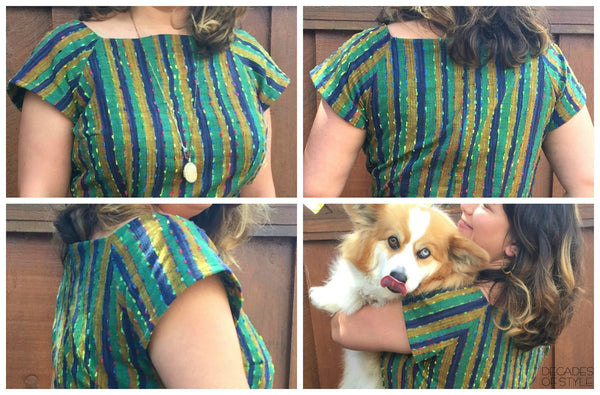
(Gratuitous photo of adorable corgi a blatant an attempt to increase readership)
We then transferred that adjustment to the pattern so that she will always have a shortened sleeve option.
Elastic band sleeve
If you like the sleeve as it is but want an easy change, try adding elastic to the sleeve hem. We used a 1/4" elastic cut to 1 inch larger than the bicep measurement (14") and used a 1/4" seam allowance (don't sew the ends together yet). If the elastic is too tight, you're feel like you've got a tourniquet on your arm, so test the band to make sure its comfortable.
Iron the sleeve hem up 1/4".

Now, iron the sleeve hem an additional 1/2". Pin and sew the hem close to the folded edge leaving 1" on either side of the side seam.

With your casing all but finished, attach a small safety pin to one end of the elastic and draw it though the casing. Sew the elastic ends together with a big zig-zag stitch. Finally, sew down the 2" of the casing at the side seam.

You now have a slightly gathered sleeve.

(Glamorous movie star scarf and sunglasses enhance the awesomeness of this sleeve option)
Next time: Cap sleeve and sleeveless
E.S.P. Sew Along: OK Pleats For Real This Time June 01 2016
Okeedoke. Onto the topic of skirt fullness and pleating. The E.S.P. pattern has a skirt softly gathered at the waistline a ratio of 2:1 fullness. This means for every one inch of the waist measurement, there are two inches of skirt.

Gathering the skirt at the waistline creates a certain amount of bulk depending on the ratio and the heaviness of your fabric. To achieve the luxurious look of a fuller skirt without added bulk at the waistline, PLEATS! Pleats might have a bad rep for being harder to do than straight gathering. And yes, there are more steps to the process but it is TOTALLY doable even for someone newer to sewing.
Our preferred fullness ratio for a pleated skirt is a 3:1. To get this number, we measure the waist edge of bodice front after the darts are sewn and minus the seam allowance, and then multiply that number by three. For the Skirt Front on the size 40 we need a piece that is 19" x 3 or 57" wide. For each Skirt Back, we need pieces that are 10" x 3 or 30" wide. For the length, you can work from the pattern piece (it is just at or above the knee so if this is too short for your taste, use the skirt length from a pattern you like.)
We cut our Skirt Front piece at 57"x 25" and our two Skirt Back pieces at 30"x 25" each. Next, we transfer our skirt markings (pocket position on the side seams and zipper position on the center back seam). We will be doing one direction knife pleats, but there are lots of pleating options. The Yellow Spool has a very clear tutorial on three different pleats: knife, inverted box and box.
For this dress, we made fewer pleats that are fairly deep. This is not a surgically precise way of making pleats. But it doesn't matter because no one will be measuring the pleats on your dress when you are finished. The goal is to make them appear uniform. If they are off by 1/8" or 1/4," it won't be noticeable. If free wheelin' gorilla pleating sets off your OCD, then the math version is to divide the waist front measurement by the number of pleats you want (this gives you the depth of each pleat.) Repeat for the back using an even number so you can have the same number of pleats on either side of the center back zipper.
Laying out the skirt front (right side down), we first marked the seam allowances.

Measuring from the seam line, we place a pin at the distance our our chosen pleat depth of 1 1/2" (Pin A), followed by a pin at 3" (Pin B) Repeat this configuration all the way across the Skirt Front piece and the two Skirt Back pieces.

When you bring Pin A to Pin B, you will get a knife pleat that is 1 1/2" deep.

The pleats should abut one another with no spacing between.

There was a bit of unpinning and redistributing to get the fabric worked down to the waist line but any unevenness is not noticeable.

Other gathering and pleating options:

From left to right: 2:1 gathered, 3:1 gathered, 4:1 box pleated (too much fabric to gather), 3:1 pleated changing direction at the Center Front (box pleat) and Center Back (inverted box pleat).
Next up: Sleeves!

